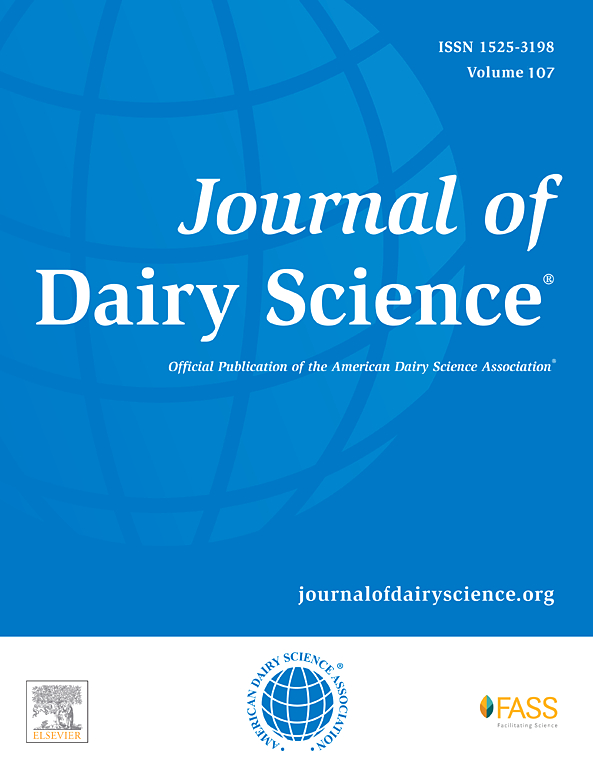标记加权提高了北欧红牛和泽西牛乳牛群体乳房健康性状的单步基因组预测可靠性。
IF 4.4
1区 农林科学
Q1 AGRICULTURE, DAIRY & ANIMAL SCIENCE
引用次数: 0
摘要
标准的单步基因组预测模型假定所有 SNP 标记都能解释等量的遗传变异,但事实可能并非如此。这是因为 SNP 位于具有不同功能的不同基因中或基因附近。因此,在预测基因组育种值时,考虑 SNP 标记的特定权重似乎是合乎逻辑的。我们假设,允许每个 SNP 标记所解释的遗传变异量存在差异将提高预测的可靠性和对选择的响应。为了研究这一假设,我们首先根据目前针对北欧红牛(RDC)和泽西牛(JER)乳房健康性状的多性状随机回归评估模型,开发了多性状标准单步基因组模型。该模型包括 4 个临床乳腺炎(CM)性状、3 个测试日体细胞评分(SCS)性状以及前乳房附着力和乳房深度的构象性状。第二步,我们研究了在单步基因组预测模型中应用不同 SNP 标记加权方案的效果,为此应用了单步 SNP 最佳线性无偏预测模型。我们通过前瞻性预测研究了不同模型的预测可靠性,在前瞻性预测中去掉了最后 4 年的数据,以估算验证候选者的育种值。此外,我们还考察了基于血统的估计育种值(PEBV)和基因组增强育种值(GEBV)的遗传趋势。RDC 和 JER 的数据集分别包括 690 万头和 120 万头动物,其中有记录的奶牛分别为 560 万头和 90 万头。RDC 和 JER 的基因分型动物数量分别为 125,789 头和 64,777 头。奶牛有重复的 SCS 观测数据,但对所有其他性状只有单次观测数据,所有性状的育种值都用一个协方差函数建模。这就需要为每头奶牛的 12 个特征值育种值系数建模,并为主成分而不是生物性状制定 SNP 标记权重。我们研究了 3 种 SNP 标记加权方案:1)与 BayesA 相似的非线性方法;2)使用经典公式 2pqû2,该公式考虑了等位基因的杂合性;3)对每 20 个相邻 SNP 标记应用由 2pqû2 计算出的平均 SNP 权重。使用基于完整数据集的评估得出的 PEBV 或 GEBV 计算偏差、离散度和预测可靠性。我们发现,自从引入基因组选择以来,近期 CM 和 SCS 的有利遗传趋势加快了。研究还表明,与基于血统的预测模型相比,标准的单步基因组预测模型可显著提高 CM 的预测可靠性,即 RDC 为 0.74,而 JER 牛为 0.48;JER 牛为 0.72,而 JER 牛为 0.41。几乎所有采用 SNP 标记加权的方案都进一步提高了预测可靠性,提高幅度在 0.5% 到 12.7% 之间。根据 2pqû2 公式对 SNP 标记进行加权的改进幅度最大。本文章由计算机程序翻译,如有差异,请以英文原文为准。
Marker weighting improves single-step genomic prediction reliabilities of udder health traits in Nordic Red and Jersey dairy cattle populations
The standard single-step genomic prediction model assumes that all SNP markers explain an equal amount of genetic variance, which, however, may not be true. This is because SNPs are located in or near different genes with different functions. Therefore, it seems logical to consider SNP marker-specific weights when predicting genomic breeding values. We hypothesized that allowing differences in the amount of genetic variance explained by each SNP marker will improve prediction reliability and response to selection. To investigate this hypothesis, we first developed multitrait standard single-step genomic models based on the current multitrait random regression evaluation models for udder health traits of the Nordic Red (RDC) and Jersey (JER) dairy cattle populations. The models included 4 clinical mastitis (CM) traits, 3 test-day SCS traits, and the conformation traits fore udder attachment and udder depth. In the second step, we investigated the effect of applying different SNP marker weighting scenarios in the single-step genomic prediction models, for which a single-step SNP best linear unbiased prediction model was applied. We investigated the prediction reliability of the different models by forward prediction, where the last 4 years of the data were removed to estimate breeding values for validation candidates. In addition, genetic trends of the pedigree-based estimated breeding values (PEBV) and GEBV were examined. The datasets for RDC and JER included 6.9 million and 1.2 million animals, of which 5.6 million and 0.9 million cows had records, respectively. The number of genotyped animals was 125,789 and 64,777 for RDC and JER, respectively. Cows had repeated SCS observations but only single observations for all other traits and breeding values for all traits were modeled by one covariance function. This required modeling 12 eigenvalue breeding value coefficients for each cow and developing SNP marker weights for the principal components rather than for the biological traits. We investigated 3 SNP marker weighting scenarios: (1) a nonlinear method similar to BayesA, (2) using the classical formula 2pqû2 that accounts for allele heterozygosity, and (3) applying a mean SNP weight calculated by 2pqû2 for every 20 adjacent SNP markers. Bias, dispersion, and prediction reliability were calculated using PEBV or GEBV from the evaluation based on the full dataset on those using the reduced dataset. We found that the recent favorable genetic trend in CM and SCS has been accelerated since the introduction of genomic selection. The study also shows that a significant increase in prediction reliability, i.e., 0.74 versus 0.48 for RDC and 0.72 versus 0.41 for JER cows for CM, can be achieved with a standard single-step genomic prediction model compared with a pedigree-based prediction model. Almost all scenarios with SNP marker weighting further improved the prediction reliability between 0.5% and 12.7%. The highest improvement was achieved by weighing the SNP markers based on the 2pqû2 formula.
求助全文
通过发布文献求助,成功后即可免费获取论文全文。
去求助
来源期刊

Journal of Dairy Science
农林科学-奶制品与动物科学
CiteScore
7.90
自引率
17.10%
发文量
784
审稿时长
4.2 months
期刊介绍:
The official journal of the American Dairy Science Association®, Journal of Dairy Science® (JDS) is the leading peer-reviewed general dairy research journal in the world. JDS readers represent education, industry, and government agencies in more than 70 countries with interests in biochemistry, breeding, economics, engineering, environment, food science, genetics, microbiology, nutrition, pathology, physiology, processing, public health, quality assurance, and sanitation.
 求助内容:
求助内容: 应助结果提醒方式:
应助结果提醒方式:


